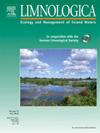Simultaneous monitoring of algal bloom and aquatic vegetation in eutrophic shallow lakes of the middle and lower yangtze river basin using deep learning
IF 2
4区 环境科学与生态学
Q2 LIMNOLOGY
引用次数: 0
Abstract
In recent years, lake ecosystems have faced severe challenges, including the increasingly severe problem of lake eutrophication and the rapid degradation of aquatic vegetation (AV). These issues pose significant threats to water quality, biodiversity, and human health. Traditional methods struggle to accurately and simultaneously monitor algal bloom (AB) and AV due to their similar spectral characteristics. Furthermore, existing studies have predominantly focused on large lakes, leaving small and medium-sized lakes understudied. This study addresses these gaps by employing the UNet+ + deep learning model to simultaneously map AB and AV in 44 eutrophic shallow lakes (area>20 km²) in the middle and lower Yangtze River Basin (MLY). Utilizing Landsat remote sensing images from 2013 to 2023, the research provides a comprehensive analysis of the spatiotemporal dynamics of AB and AV. The results reveal significant spatiotemporal variations in AB and AV distribution. Additionally, the number of lakes experiencing algal bloom increased significantly (p < 0.01), and the area of aquatic vegetation exhibited a significant decrease. Unlike previous studies that focused on single categories or large lakes, this research addresses the complexity of "grass-algae coexistence" and provides a comprehensive understanding of their spatiotemporal dynamics. This research not only advances the application of deep learning in aquatic ecosystem monitoring, but also provides valuable insights for lake management and ecological restoration in the MLY region.
基于深度学习的长江中下游富营养化浅湖藻华与水生植被同步监测
近年来,湖泊生态系统面临着严峻的挑战,湖泊富营养化问题日益严重,水生植被迅速退化。这些问题对水质、生物多样性和人类健康构成重大威胁。由于藻华(AB)和藻华(AV)的光谱特征相似,传统的方法难以同时准确地监测它们。此外,现有的研究主要集中在大型湖泊,而对中小型湖泊的研究不足。本研究利用UNet+ +深度学习模型对长江中下游44个富营养化浅湖(面积20 km²)进行AB和AV同步映射,解决了这些空白。利用2013 - 2023年的Landsat遥感影像,对AB和AV的时空动态进行了综合分析,结果表明AB和AV的分布具有明显的时空变化特征。此外,发生藻华的湖泊数量显著增加(p <; 0.01),水生植被面积显著减少。不同于以往的研究集中在单一类别或大型湖泊上,本研究解决了“草藻共存”的复杂性,并提供了对其时空动态的全面理解。该研究不仅推进了深度学习技术在水生生态系统监测中的应用,而且为湖泊管理和生态恢复提供了有价值的见解。
本文章由计算机程序翻译,如有差异,请以英文原文为准。
求助全文
约1分钟内获得全文
求助全文
来源期刊

Limnologica
环境科学-湖沼学
CiteScore
3.70
自引率
5.90%
发文量
64
审稿时长
3 months
期刊介绍:
Limnologica is a primary journal for limnologists, aquatic ecologists, freshwater biologists, restoration ecologists and ecotoxicologists working with freshwater habitats.
 求助内容:
求助内容: 应助结果提醒方式:
应助结果提醒方式:


